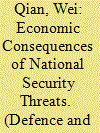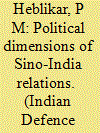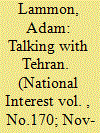| Srl | Item |
| 1 |
ID:
172639


|
|
|
|
|
| Summary/Abstract |
In India while nature and range of threats from China and Pakistan have changed, the structure of the forces to counter these threats has remained constant. Each Service views its strategic and operational role in isolation. Joint-ness and integration in operations come secondary to individual service assumed roles and goals. This has led to lack of synergy in operations. Apart from being a manpower intensive armed force, there is lack of interoperability between the forces with neither commonality of equipment nor economies of scale. Shortcomings in the current structure also impact force application. Besides this, the current sectoral area of responsibility and existing allocation of forces make force application predictable. The armed forces within themselves have seventeen individual service commands, most of which are neither co-located nor co-purposed. There are seven single service commands facing China as compared to a single Chinese Western Command deployed across. The existing shortcomings mandate that the system be rehauled to bring about better synergy in every aspect spread from training, capability development to operations.
|
|
|
|
|
|
|
|
|
|
|
|
|
|
|
|
| 2 |
ID:
192058


|
|
|
|
|
| Summary/Abstract |
This paper examines the impact of national security threats on a nation’s economic growth and fiscal policy based on a case study of the Korean peninsula. I construct four measures of provocations using a newly-assembled list of North Korean provocative events going back to 1960. The results show that the overall impact of North Korean provocations on South Korea’s short-run economic growth is negligible. Since inter-Korean relations have gone through four phases, this paper also estimates the impact of provocations over each subperiod. Provocations had a significant impact on South Korea’s economic growth during 1960-1970 and 1992-1997 when inter-Korean tensions were high, but the effects took on different signs. While provocations decreased South Korea’s economic growth during 1992-1997, it had a positive impact on South Korea’s macroeconomy before 1970. This paper provides evidence that the effect of national security threats may vary with the responses from the government and political factors such as the relation between the targeted country and the country that inflicts the threat.
|
|
|
|
|
|
|
|
|
|
|
|
|
|
|
|
| 3 |
ID:
115196


|
|
|
|
|
| Publication |
2012.
|
| Summary/Abstract |
The United States has launched, in effect, an economic, political, cyber and covert war with Iran. American-Iranian relations could reach a turning point within a year. Without substantial progress on the diplomatic front, the chance for a unilateral Israeli or a joint US-Israeli military campaign aimed at destroying the Iranian nuclear programme could become a probability. Any attempt to reorient the current diplomatic trajectory will require a better understanding of the dispute between Tehran and Washington over nuclear and other weapons of mass destruction (WMD).
|
|
|
|
|
|
|
|
|
|
|
|
|
|
|
|
| 4 |
ID:
111052


|
|
|
| 5 |
ID:
174921


|
|
|